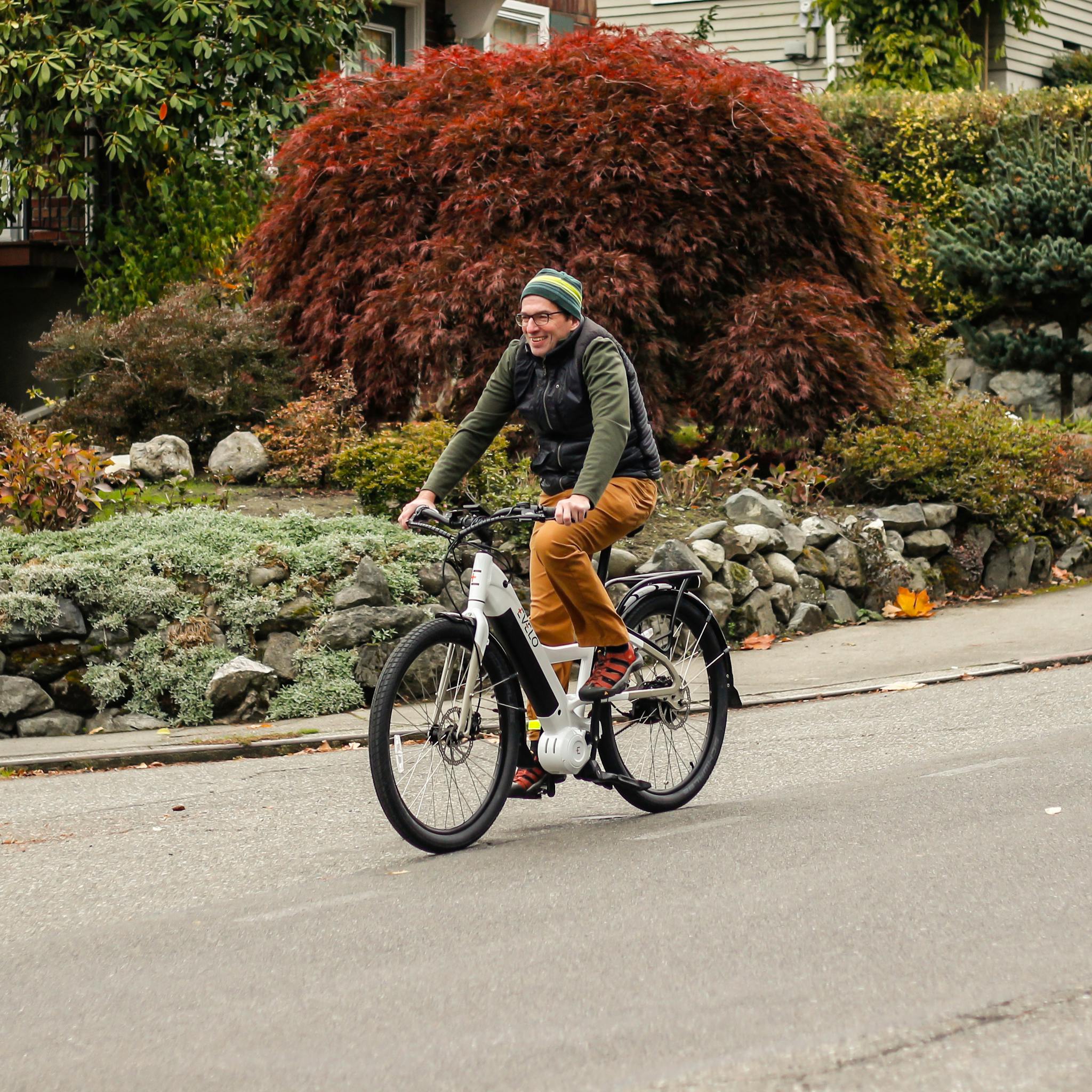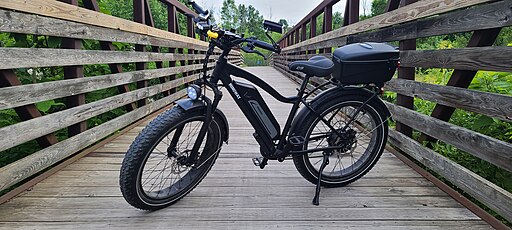Save $1000 a Year on Gas: How E-Bikes Can Slash Your Transportation Costs
Last Updated on July 3, 2024 by Kristina Grant
Feeling the pinch at the pump? According to the latest AAA gas prices survey [Source: AAA gas prices survey], the average American driver spends over $2,000 a year on gasoline alone. With fuel costs steadily climbing and car ownership factoring in maintenance, insurance, and parking fees, the financial burden of traditional transportation is becoming increasingly significant.
But what if there was a way to slash your transportation costs and ditch the gas station altogether? Enter the electric bike, or e-bike for short. These innovative cycles are rapidly gaining popularity as a practical and eco-friendly alternative for commuting and everyday errands.
This blog post will explore how e-bikes can be a game-changer for your wallet and your lifestyle. We’ll delve into the potential cost savings you can achieve by switching to electric power, showcase the versatility of e-bikes for various needs, and address common concerns about these exciting vehicles.
By the end, you’ll be equipped with the knowledge to decide if e-bikes are the key to unlocking a more affordable and sustainable transportation experience.
Key Takeaways
- Rising gas prices and car ownership costs are a significant financial burden.
- E-bikes offer a cost-effective and eco-friendly alternative for commuting and short trips.
- You can potentially save $1000 or more annually on gas by switching to an e-bike.
- E-bikes can travel 20-40 miles on a single charge, making them suitable for many commutes.
- E-bikes come in various styles and price ranges to suit different needs and
- E-bikes are a fun and healthy way to get around, offering a low-impact exercise option.
- With proper research and maintenance, e-bikes can be a reliable and enjoyable mode of transportation.
The Problem: Rising Gas Costs and the True Cost of Car Ownership
The pain at the pump is a real concern for many. As of today, the average price of a gallon of gas in the United States sits at $[current gas price per gallon] according to AAA [Source: AAA gas prices survey]. This translates to a significant annual expense, especially for those with longer commutes or frequent errands. But gas isn’t the only cost associated with getting around by car.
The hidden drain of car ownership:
- Maintenance: Regular oil changes, tire rotations, and unforeseen repairs can add up quickly.
- Insurance: Comprehensive and collision coverage are significant expenses, and rates can vary depending on your location and driving history.
- Parking: Parking fees, especially in urban areas, can eat into your budget on a daily basis.
Considering a 5-mile commute: Let’s say you drive a car that gets an average of 25 miles per gallon. For a 5-mile commute, you might only spend a dollar or two on gas each way. However, when you factor in car maintenance, insurance, and potential parking costs, the daily cost can easily double or even triple.
Public transportation isn’t always the answer: While public transportation can be a budget-friendly option in some areas, it’s not always readily available or convenient. Limited routes, wait times, and potential schedule conflicts can make it a less than ideal solution for everyone.
The high cost of traditional transportation is a pressing issue for many. The good news is, there’s a solution that can significantly reduce your expenses and offer a more sustainable alternative.
RELATED CONTENT
The Solution: E-bikes – Slashing Costs and Cruising Towards Sustainability
Electric bikes, or e-bikes, are revolutionizing the way we think about commuting and everyday transportation. Unlike traditional bicycles, e-bikes come equipped with an electric motor that provides an extra boost when pedaling. This translates to several key benefits for commuters:
- Effortless commutes: E-bikes take the strain out of riding, especially on hills or longer distances. The electric motor assists your pedaling, allowing you to arrive at your destination feeling refreshed and ready to take on the day.
- Reduced sweat and stress: No more arriving at work drenched in sweat! E-bikes help you manage your exertion level, making them a fantastic option for those who want to enjoy the benefits of cycling without the physical intensity.
- Beat traffic congestion: Traffic jams become a thing of the past when you’re zipping through on an e-bike. Navigate city streets with ease and shave valuable time off your commute.
Can e-bikes replace cars for short trips? Absolutely! A [link to study on e-bike usage] study by [source of the study] found that a significant portion of car trips are actually under 5 miles, a distance perfectly suited for e-bikes. Imagine ditching the car for your daily errands, grocery runs, or even grabbing coffee with a friend. E-bikes offer a convenient and eco-friendly way to navigate your local area.
Now, let’s talk about the real game-changer: cost savings! Compared to gas-powered vehicles, e-bikes offer significant financial advantages:
- Minimal running costs: The electricity required to charge an e-bike is a fraction of the cost of filling up a gas tank. You’re looking at mere pennies per charge.
- Reduced maintenance: E-bikes have fewer moving parts compared to cars, resulting in lower maintenance costs. Say goodbye to expensive oil changes and unexpected repairs.
- No parking fees: Finding parking, especially in crowded urban areas, can be a hassle and a financial burden. With an e-bike, parking becomes a breeze. Simply lock it up at your destination and enjoy the freedom of a more nimble mode of transportation.
By switching to an e-bike for everyday commutes and errands, you can potentially save thousands of dollars annually compared to the ongoing costs of car ownership. Not only is it good for your wallet, but it’s also a win for the environment!
Breakdown of the Savings: E-bikes vs. Gas
Let’s dive deeper into the cost savings you can achieve by making the switch to electric power. Here’s a breakdown of the key factors:
- Electricity vs. Gas: The cost of charging an e-bike is significantly lower than filling up a gas tank. Typically, a full charge for an e-bike battery costs just pennies, depending on your electricity rate. In contrast, filling a gas tank can set you back anywhere from $[current gas price per gallon] x number of gallons in your car’s tank.
Example Calculation (consider including a disclaimer about fluctuating gas prices):
Imagine you have a 5-mile commute each way to work and your car gets an average of 25 miles per gallon. For a round trip commute, you’d use approximately 0.4 gallons of gas per day (5 miles / 25 mpg = 0.2 gallons x 2 for round trip). With gas prices at $[current gas price per gallon], that translates to a daily cost of around $[current gas price per gallon] x 0.4 = $[daily gas cost].
In comparison, a full charge for a typical e-bike battery might cost around $0.10. Even with daily charging, that’s a significant difference!
Extrapolating the Savings:
Now, let’s consider the annual savings. If you factor in a 250-day work year (accounting for weekends and holidays), using the example above, you could potentially save:
- Gas cost per year: $[daily gas cost] x 250 work days = $[annual gas cost]
- E-bike charging cost per year: $0.10 x 250 days = $25
That’s a potential annual saving of $[annual gas cost] – $25 on gas alone! This doesn’t even take into account the additional ongoing costs associated with car ownership, like maintenance and insurance, which can further amplify the financial benefits of e-bikes.
Long-Term Cost of Ownership: When you consider the long-term picture, e-bikes offer a clear advantage. Their lower maintenance requirements and minimal running costs translate to significant savings compared to gas-powered vehicles.
By making the switch to an e-bike, you’re not just saving money on gas today – you’re investing in a more affordable and sustainable transportation solution for the future.
Addressing Concerns and Expanding Your E-bike Horizons
E-bikes sound like a fantastic option, but you might have some questions. Let’s address a few common concerns:
- Range Anxiety: How far can I really go on a single charge?
E-bike range varies depending on the battery capacity, motor power, terrain, and rider weight. However, most e-bikes can travel between 20-40 miles on a single charge, making them suitable for commuting and running errands around town. Additionally, many e-bikes are equipped with quick-charging batteries, so you can easily top up the charge during your workday or while grabbing coffee. - Riding in all Weathers: While e-bikes aren’t designed for extreme weather conditions, many are built to withstand rain and splashes. With proper care, such as using fenders and keeping the battery dry, you can enjoy riding your e-bike year-round in most climates. For winter riding, consider using studded tires for added traction on icy roads.
- Conquering Hills: Worried about tackling those pesky inclines? E-bikes come with a variety of motor wattages. For hilly commutes, opt for an e-bike with a higher wattage motor that can provide extra assistance on steep climbs.
Now that we’ve addressed some concerns, let’s explore the versatility of e-bikes! They’re not just for commuting:
- Grocery Shopping: Many e-bikes come equipped with racks or baskets, making them perfect for grocery shopping trips. Stock up on your essentials and enjoy the ride home without breaking a sweat.
- Errand Day Champion: Running errands around town becomes a breeze with an e-bike. No more searching for parking or waiting for public transportation. Zip through your to-do list with ease and efficiency.
- Exercise Buddy: E-bikes are a fantastic way to get some exercise and enjoy the outdoors. The electric motor provides assistance, allowing you to ride further and explore more while still getting a good workout.
E-bikes are a fun, practical, and eco-friendly way to get around. Whether you’re looking to save money on gas, reduce your environmental impact, or simply enjoy a more convenient mode of transportation, e-bikes offer a compelling solution. So ditch the car for your next commute or errand run, and experience the joy of riding an e-bike!
Making the Switch to E-bikes: Your Guide to Finding the Perfect Ride
Excited to join the e-bike revolution? Here’s a helpful guide to selecting the perfect e-bike for your needs and budget:
Consider these key factors before you buy:
- Budget: E-bikes range in price depending on features, motor power, and battery capacity. While high-end models can reach up to several thousand dollars, there are plenty of excellent options available under $2000. Determine your budget and prioritize the features most important to you.
- Features: E-bikes come with a variety of features, such as different motor wattages, pedal-assist options, and display screens. Consider how you’ll be using your e-bike and choose features that enhance your riding experience. For example, if you plan on tackling hilly commutes, a higher wattage motor will provide more assistance.
- Range: As mentioned earlier, e-bike range typically falls between 20-40 miles on a single charge. Think about the distance of your commute and errands to ensure the e-bike you choose can handle your daily needs.
Here are some additional resources to help you on your e-bike buying journey:
- Online reviews: Research different e-bike models and read reviews from other riders.
- Local e-bike shops: Test riding different e-bikes at your local shop is a great way to get a feel for which one suits you best. Ask the staff questions about features, maintenance, and accessories.
- Consider your body type : E-bikes come in various frame sizes and styles. Ensure you choose one that offers a comfortable and safe riding position for your height and weight. Some stores may even offer recommendations for “Best electric bike for heavy riders”.
With a little research and planning, you’re sure to find the perfect e-bike that fits your style, budget, and riding needs.
Additional Benefits of E-bikes: Beyond Saving Money and Embracing Sustainability
While the cost savings of e-bikes are a major perk, the environmental benefits are equally compelling. By opting for electric power, you’re making a positive impact on the planet:
- Reduced Emissions: Unlike gas-powered vehicles, e-bikes produce zero tailpipe emissions [Source: [Environmental impact of e-bikes]. This translates to cleaner air and reduced greenhouse gas contributions, which is crucial for combating climate change.
- Sustainable Transportation: E-bikes rely on electricity, which can be generated from renewable sources like solar or wind power. This promotes a cleaner and more sustainable transportation system compared to our current dependence on fossil fuels.
- Reduced Traffic Congestion: With more people opting for e-bikes, traffic congestion can be significantly reduced. This not only saves time for everyone on the road, but also contributes to a more breathable and peaceful urban environment.
By choosing an e-bike, you’re not just saving money on gas – you’re taking a stand for a healthier planet and a more sustainable future.
FAQs
E-bike regulations vary depending on your location. Some areas classify them as bicycles, while others might require a permit or registration. Always check your local e-bike laws before riding.
A properly fitted helmet is essential. Depending on your local traffic laws and riding style, you might also consider wearing reflective gear, gloves, and eyewear.
E-bikes can be a great option for people of most ages and fitness levels. However, it’s important to choose an e-bike that suits your physical capabilities and comfort level.
E-bikes generally require less maintenance than gas-powered vehicles. Regular chain lubrication, tire pressure checks, and basic cleaning are essential. Consult your e-bike’s manual for specific maintenance recommendations.
For basic maintenance tasks, you might be able to handle them yourself. However, for more complex repairs, it’s best to consult a qualified e-bike mechanic.
E-bike speed limitations vary depending on regulations and the specific model. Many e-bikes have a maximum assisted speed of 20-25 mph.
Absolutely! Many e-bikes are compatible with a variety of accessories, such as baskets, fenders, lights, and cargo racks. Customize your e-bike to fit your needs and riding style.
Many cities are increasingly offering designated parking for bicycles and e-bikes. You can also use traditional bike racks or secure your e-bike with a lock at your destination
Most bike paths welcome e-bikes, but it’s always a good idea to check signage or local regulations to be sure.
Conclusion:
So, are you ready to ditch the gas pump and join the e-bike revolution? We’ve explored the many advantages of e-bikes, from significant cost savings to environmental benefits and a more enjoyable riding experience.
Remember, with rising gas prices and car ownership expenses, e-bikes can potentially save you up to $1,000 per year on transportation costs. That’s money you can put towards other things you enjoy!
E-bikes aren’t just economical – they’re a fun and sustainable way to get around. Imagine cruising through your city, breathing clean air, and leaving a smaller environmental footprint.
Ready to take the leap? Here are some helpful resources to get you started:
- E-bike Finder: Use online resources or visit your local e-bike shops to explore different models and find the perfect fit for you.
- Government Incentives: Did you know some states and localities offer e-bike rebates or tax credits?
Keep in mind that e-bikes, like any vehicle, require some maintenance. While significantly less than gas-powered vehicles, there will be occasional costs associated with keeping your e-bike in top condition. Factor this into your decision, but remember, the long-term savings and environmental benefits often outweigh these minor expenses.
E-bikes are the future of transportation, offering a practical, affordable, and eco-friendly solution for getting around. So why wait? Start exploring the exciting world of e-bikes today and experience the joy of a more sustainable and enjoyable ride!
Kristina Grant is not just an enthusiast but a true authority on electric bikes. Nestled in the coastal beauty of Virginia, Kristina has found the perfect backdrop for her passion for electric biking. As a dedicated wife and homeschooling mom, her life revolves around family, faith, and the thrill of adventure.
Originally hailing from Ohio, Kristina's journey with electric bikes began as a curiosity and quickly evolved into a deep expertise. Her blog is a testament to her love for electric biking, combining her fascination for eco-friendly transportation with her coastal lifestyle.
When she's not cruising the beach on her electric bike, you'll find Kristina indulging in her other loves: long walks along the shore, getting lost in a good book, and cherishing moments with her loved ones. With a heart as big as her love for animals, especially cats, Kristina brings a unique perspective to the electric bike world, grounded in her strong faith in God and her dedication to a sustainable lifestyle.
Through her blog, Kristina shares her extensive knowledge of electric bikes, offering valuable insights, tips, and recommendations to fellow enthusiasts. Whether you're a seasoned rider or a newcomer to the electric bike scene, Kristina's blog is your go-to source for all things electric biking, fueled by her passion, expertise, and the scenic beauty of coastal Virginia.





